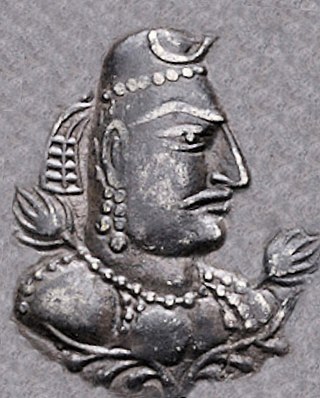
Peroz I was the Sasanian King of Kings of Iran from 459 to 484. A son of Yazdegerd II, he disputed the rule of his elder brother and incumbent king Hormizd III, eventually seizing the throne after a two-year struggle. His reign was marked by war and famine. Early in his reign, he successfully quelled a rebellion in Caucasian Albania in the west, and put an end to the Kidarites in the east, briefly expanding Sasanian rule into Tokharistan, where he issued gold coins with his likeness at Balkh. Simultaneously, Iran was suffering from a seven-year famine. He soon clashed with the former subjects of the Kidarites, the Hephthalites, who possibly had previously helped him to gain his throne. He was defeated and captured twice by the Hephthalites and lost his recently acquired possessions.

Shapur II, also known as Shapur the Great, was the tenth Sasanian King of Kings (Shahanshah) of Iran. He took the title at birth and held it until his death at age 70, making him the longest-reigning monarch in Iranian history. He was the son of Hormizd II.
The Hephthalites, sometimes called the White Huns, were a people who lived in Central Asia during the 5th to 8th centuries CE, part of the larger group of the Iranian Huns. They formed an empire, the Imperial Hephthalites, and were militarily important from 450 CE, when they defeated the Kidarites, to 560 CE, when combined forces from the First Turkic Khaganate and the Sasanian Empire defeated them. After 560 CE, they established "principalities" in the area of Tokharistan, under the suzerainty of the Western Turks and of the Sasanian Empire, before the Tokhara Yabghus took over in 625.

The Kushan Empire was a syncretic dynastic empire formed by the Yuezhi in the Bactrian territories in the early 1st century. It spread to encompass much of what is now Uzbekistan, Afghanistan, Pakistan, and Northern India, at least as far as Saketa and Sarnath, near Varanasi, where inscriptions have been found dating to the era of the Kushan emperor Kanishka the Great.

Bactrian is an extinct Eastern Iranian language formerly spoken in the Central Asian region of Bactria and used as the official language of the Kushan and the Hephthalite empires.

Xionites, Chionites, or Chionitae were a nomadic people in the Central Asian regions of Transoxiana and Bactria.
The Kidarites, or Kidara Huns, were a dynasty that ruled Bactria and adjoining parts of Central Asia and South Asia in the 4th and 5th centuries. The Kidarites belonged to a complex of peoples known collectively in India as the Huna, and in Europe as the Chionites, and may even be considered as identical to the Chionites. The 5th century Byzantine historian Priscus called them Kidarite Huns, or "Huns who are Kidarites". The Huna/Xionite tribes are often linked, albeit controversially, to the Huns who invaded Eastern Europe during a similar period. They are entirely different from the Hephthalites, who replaced them about a century later.

Kushano-Sasanian Kingdom was a polity established by Sasanian Persians in Bactria during the 3rd and 4th centuries CE. The Sasanian Empire captured the provinces of Sogdiana, Bactria and Gandhara from the declining Kushan Empire following a series of warsin 225 CE. The local Sasanian governors then went on to take the title of Kushanshah or "King of the Kushans", and to mint their own coins. They are sometimes considered as forming a "sub-kingdom" inside the Sasanian Empire. This administration continued until 360-370 CE, when the Kushano-Sasanians lost much of their domains to the invading Kidarite Huns, whilst the rest was incorporated into the imperial Sasanian Empire. Later, the Kidarites were in turn displaced by the Hephthalites. The Sasanians were able to re-establish some authority after they destroyed the Hephthalites with the help of the Turks in 565, but their rule collapsed under Arab attacks in the mid 7th century.
Kama Tarkhan was a legendary ancestor-king of the Altyn Oba Horde located on the steppes to the north of the Black Sea.

Ariana was a general geographical term used by some Greek and Roman authors of the ancient period for a district of wide extent between Central Asia and the Indus River, comprising the eastern provinces of the Achaemenid Empire that covered the whole of modern-day Afghanistan, as well as the easternmost part of Iran and up to the Indus River in Pakistan. Ariana is the Latinized form of the Ancient Greek Ἀρ(ε)ιανή Ar(e)ianē, originating from the Old Persian word Ariyanem (Ariana) meaning 'the Land of the Aryans', similar to the use of Āryāvarta.
Hunas or Huna was the name given by the ancient Indians to a group of Central Asian tribes who, via the Khyber Pass, entered the Indian subcontinent at the end of the 5th or early 6th century. The Hunas occupied areas as far south as Eran and Kausambi, greatly weakening the Gupta Empire. The Hunas were ultimately defeated by a coalition of Indian princes that included an Indian king Yasodharman and the Gupta emperor, Narasimhagupta. They defeated a Huna army and their ruler Mihirakula in 528 CE and drove them out of India. The Guptas are thought to have played only a minor role in this campaign.

Central Asian art is visual art created in Central Asia, in areas corresponding to modern Kyrgyzstan, Kazakhstan, Uzbekistan, Turkmenistan, Azerbaijan, Tajikistan, Afghanistan, Pakistan, and parts of modern Mongolia, China and Russia. The art of ancient and medieval Central Asia reflects the rich history of this vast area, home to a huge variety of peoples, religions and ways of life. The artistic remains of the region show a remarkable combinations of influences that exemplify the multicultural nature of Central Asian society. The Silk Road transmission of art, Scythian art, Greco-Buddhist art, Serindian art and more recently Persianate culture, are all part of this complicated history.

Tapuri or Tapyri were a tribe in the Medes south of the Caspian Sea mentioned by Ptolemy and Arrian. Ctesias refers to the land of Tapuri between the two lands of Cadusii and Hyrcania.

The Alchon Huns, also known as the Alkhan, Alchono, Alxon, Alkhon, Alakhana, and Walxon, were a nomadic people who established states in Central Asia and South Asia during the 4th and 6th centuries CE. They were first mentioned as being located in Paropamisus, and later expanded south-east, into the Punjab and Central India, as far as Eran and Kausambi. The Alchon invasion of the Indian subcontinent eradicated the Kidarite Huns who had preceded them by about a century, and contributed to the fall of the Gupta Empire, in a sense bringing an end to Classical India.

The term Iranian Huns is sometimes used for a group of different tribes that lived in Central Asia, in the historical regions of Transoxiana, Bactria, Tokharistan, Kabul Valley, and Gandhara, overlapping with the modern-day Afghanistan, Tajikistan, Uzebekistan, Eastern Iran, Pakistan, and Northwest India, between the fourth and seventh centuries. They also threatened the Northeast borders of Sasanian Iran and forced the Shahs to lead many ill-documented campaigns against them.
The origin of the Huns and their relationship to other peoples identified in ancient sources as Iranian Huns such as the Xionites, the Alchon Huns, the Kidarites, the Hephthalites, the Nezaks, and the Huna, has been the subject of long-term scholarly controversy. Ancient Greek and Roman sources do not provide any information on where the European Huns came from, besides that they suddenly appeared in 370 CE. However, there are some possible mentions of the Huns or tribes related to them that pre-date 370. Chinese sources, meanwhile, indicate several different, sometimes contradictory origins for the various "Iranian Hun" groups. In 1757, Joseph de Guignes first proposed that the Huns and the Iranian Huns were identical to the Xiongnu. The thesis was then popularized by Edward Gibbon. Since that time scholars have debated the proposal on its linguistic, historical, and archaeological merits. In the mid-twentieth century, the connection was attacked by the Sinologist Otto J. Maenchen-Helfen and largely fell out of favor. Some recent scholarship has argued in favor of some form of link, and the theory returned to the mainstream, but there is no consensus on the issue. It also remains disputed whether the various “Iranian Huns” belonged to a single or multiple ethnic groups.

The Gelae, or Gelians, were a Scythian tribe mentioned by Strabo and other ancient writers as living on the southern shores of the Caspian Sea. The name of the province Gilan might possibly be derived from the Gelae. Another hypothesis held by several historians, suggests that the Gelae are equivalent to the Galgai, the ancient neighbours of the Legae (Leks).
Vitii is an ancient tribe that lived on the territory of Caucasian Albania and today in village Nic Qabala region Azerbaijan udins Some scholars believe that the Vitii were Caucasian Albanians, while others consider them to have migrated to the Caucasus by the ancient Greeks. Some consider the Vitii to be the ancestors of the modern Udins, but according to other statements, these two tribes could live at the same time. V.V. Nikolaev identifies the Vitii with Gutians. A.A. Tuallagov describes the Vitii as Caucasian Tocharians and says that they came from the territory of the Yuezhi tribe.
The Dareitai were an ancient Iranian tribe whose land made up a special and large part of Media. The Dareitai and Pantimati people may have been part of the Cadusii.











